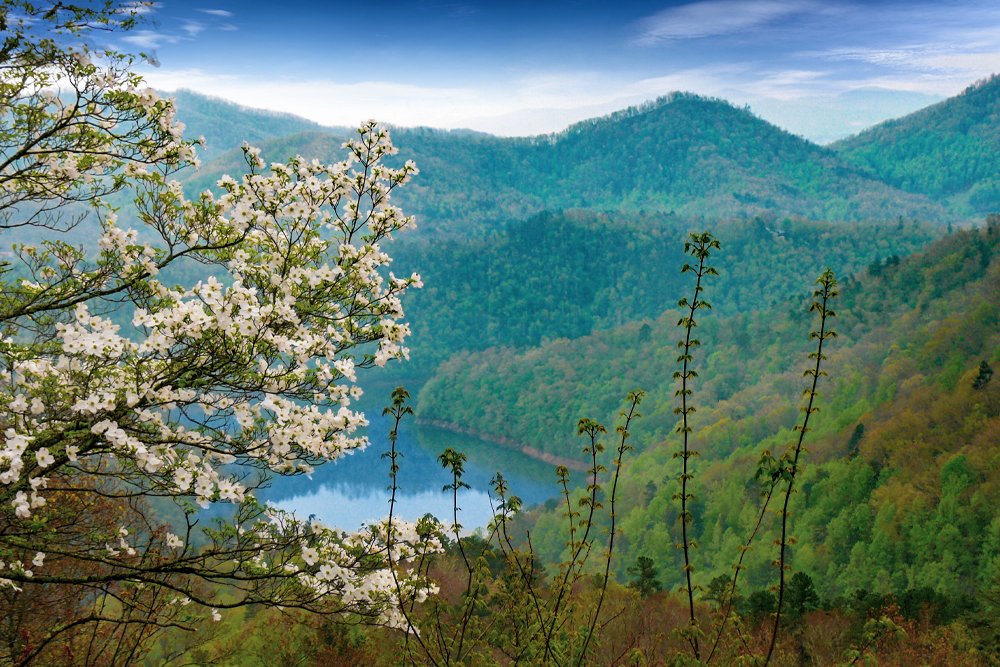When the white pelicans line up to head north, it’s crappie fishing time. (Photo: Ed Mashburn)
Signs of the (Crappie) Season
Dogwood blooms are a sure sign of crappie days ahead
by Ed Mashburn
I can’t help but put some trust in “signs” that tell me when I ought to go fishing. These signs have served me well.
In particular, I believe that there are some signals that springtime crappie anglers can use to help them figure out when the biggest slabs and the largest numbers of good fish will be in the shallows and ready to bite.

Studies indicate that in both southern parts of the country and up north, in winter, crappie tend to hold near old creek channels and other deeper water where they can find the most comfortable water and enough food to keep them going.
When the days start to lengthen in spring and the water starts to warm, the crappie will leave the deep water and gradually move up onto flats and then into spawning shallows. That’s all easy to understand.
But anglers want to know when exactly the crappie will be on the beds and easy to catch. Studies show that when the water reaches and holds at the 57 to 60-degree mark, the crappie will be spawning.
But dropping a thermometer into the water and taking readings is sort of slow, and water temps can rise and fall rapidly in spring depending on cold fronts, warm southern breezes, and a lot of other influences.
Here are a few time-honored “signs” that tell us when the crappie are ready to rumble?
Plants and Trees

Growing up in Arkansas in early spring we watched for blooms on the dogwood trees. When they bloomed bright, we knew the crappie were on the beds. Many crappie anglers also watch the redbud trees to bloom.
We also found that when the willow trees which grew along the banks of the lakes turned green, then usually the crappie would be bedding below the willows.
When we would see the bright yellow blooms of early spring daffodils around old home places in the country, we knew that it was time to load the boat, get some minnows, and head to the crappie-bedding water.
Even in the garden, when we saw the earliest planting of lettuce growing and ready to cut, the crappie would be on the beds.
Truly, plants can tell us a lot about the fish.
Pelicans and other Birds
Now, using the birds to tell us when to go crappie fishing can be difficult. This is because the birds themselves follow their own rules and they depart and arrive in springtime according to their own ideas. However, when certain birds leave one place, they will surely arrive somewhere else, a long way away, and their comings and goings can signal good crappie fishing.
For instance, in the deep South, when the white pelicans which have spent the winter here start to flock up and begin their migration north, the crappie will often be on the beds. Likewise, when the white pelicans start migrating into their summer homes up north, sometime later might be a good time to be looking for bedding crappie.
In the South, when the robins which have spent the winter enjoying the mild weather and lack of snow cover leave and head north, then it’s a good crappie fishing time. When the robins arrive up north, it’s likewise a good time to go crappie chasing.
And the most reliable bird predictor of crappie bedding? Those wonderful purple martins. When they arrive at a specific place for the spring, it’s time to go crappie fishing!
It’s not an Exact Science
Captain Lee Pitts, a crappie guide on Weiss Lake in Alabama, says that predicting by signs the exact times that the crappie will on the beds and eating up everything offered to them is not easy.
He says, “I have so many clients that call wanting to book a trip and ask ,’What are the best three days the big ‘uns are eating?’ I tell them we start catching fish from the second week in January until the first of June. I have had great days in freezing rain and snow and had some good days at the tail end of spawn with sweat running down my back. The key is to just go fishing. If you worry about the weatherman, you won’t ever catch any.”


